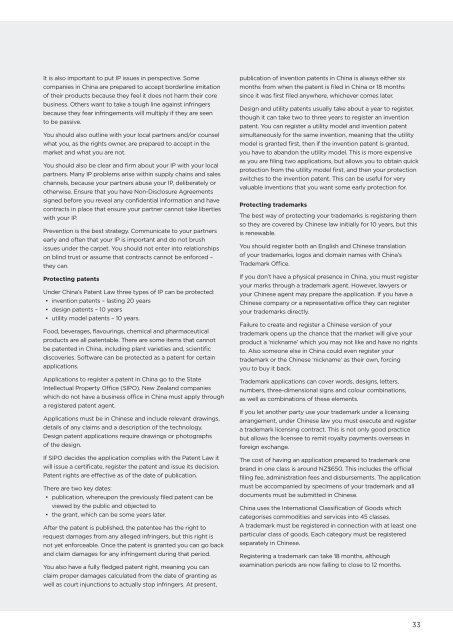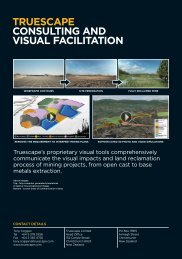Navigating China Guide (2012) - New Zealand Trade and Enterprise
Navigating China Guide (2012) - New Zealand Trade and Enterprise
Navigating China Guide (2012) - New Zealand Trade and Enterprise
Create successful ePaper yourself
Turn your PDF publications into a flip-book with our unique Google optimized e-Paper software.
It is also important to put IP issues in perspective. Some<br />
companies in <strong>China</strong> are prepared to accept borderline imitation<br />
of their products because they feel it does not harm their core<br />
business. Others want to take a tough line against infringers<br />
because they fear infringements will multiply if they are seen<br />
to be passive.<br />
You should also outline with your local partners <strong>and</strong>/or counsel<br />
what you, as the rights owner, are prepared to accept in the<br />
market <strong>and</strong> what you are not.<br />
You should also be clear <strong>and</strong> firm about your IP with your local<br />
partners. Many IP problems arise within supply chains <strong>and</strong> sales<br />
channels, because your partners abuse your IP, deliberately or<br />
otherwise. Ensure that you have Non-Disclosure Agreements<br />
signed before you reveal any confidential information <strong>and</strong> have<br />
contracts in place that ensure your partner cannot take liberties<br />
with your IP.<br />
Prevention is the best strategy. Communicate to your partners<br />
early <strong>and</strong> often that your IP is important <strong>and</strong> do not brush<br />
issues under the carpet. You should not enter into relationships<br />
on blind trust or assume that contracts cannot be enforced –<br />
they can.<br />
Protecting patents<br />
Under <strong>China</strong>’s Patent Law three types of IP can be protected:<br />
• invention patents – lasting 20 years<br />
• design patents – 10 years<br />
• utility model patents – 10 years.<br />
Food, beverages, flavourings, chemical <strong>and</strong> pharmaceutical<br />
products are all patentable. There are some items that cannot<br />
be patented in <strong>China</strong>, including plant varieties <strong>and</strong>, scientific<br />
discoveries. Software can be protected as a patent for certain<br />
applications.<br />
Applications to register a patent in <strong>China</strong> go to the State<br />
Intellectual Property Office (SIPO). <strong>New</strong> <strong>Zeal<strong>and</strong></strong> companies<br />
which do not have a business office in <strong>China</strong> must apply through<br />
a registered patent agent.<br />
Applications must be in Chinese <strong>and</strong> include relevant drawings,<br />
details of any claims <strong>and</strong> a description of the technology.<br />
Design patent applications require drawings or photographs<br />
of the design.<br />
If SIPO decides the application complies with the Patent Law it<br />
will issue a certificate, register the patent <strong>and</strong> issue its decision.<br />
Patent rights are effective as of the date of publication.<br />
There are two key dates:<br />
• publication, whereupon the previously filed patent can be<br />
viewed by the public <strong>and</strong> objected to<br />
• the grant, which can be some years later.<br />
After the patent is published, the patentee has the right to<br />
request damages from any alleged infringers, but this right is<br />
not yet enforceable. Once the patent is granted you can go back<br />
<strong>and</strong> claim damages for any infringement during that period.<br />
You also have a fully fledged patent right, meaning you can<br />
claim proper damages calculated from the date of granting as<br />
well as court injunctions to actually stop infringers. At present,<br />
publication of invention patents in <strong>China</strong> is always either six<br />
months from when the patent is filed in <strong>China</strong> or 18 months<br />
since it was first filed anywhere, whichever comes later.<br />
Design <strong>and</strong> utility patents usually take about a year to register,<br />
though it can take two to three years to register an invention<br />
patent. You can register a utility model <strong>and</strong> invention patent<br />
simultaneously for the same invention, meaning that the utility<br />
model is granted first, then if the invention patent is granted,<br />
you have to ab<strong>and</strong>on the utility model. This is more expensive<br />
as you are filing two applications, but allows you to obtain quick<br />
protection from the utility model first, <strong>and</strong> then your protection<br />
switches to the invention patent. This can be useful for very<br />
valuable inventions that you want some early protection for.<br />
Protecting trademarks<br />
The best way of protecting your trademarks is registering them<br />
so they are covered by Chinese law initially for 10 years, but this<br />
is renewable.<br />
You should register both an English <strong>and</strong> Chinese translation<br />
of your trademarks, logos <strong>and</strong> domain names with <strong>China</strong>’s<br />
<strong>Trade</strong>mark Office.<br />
If you don’t have a physical presence in <strong>China</strong>, you must register<br />
your marks through a trademark agent. However, lawyers or<br />
your Chinese agent may prepare the application. If you have a<br />
Chinese company or a representative office they can register<br />
your trademarks directly.<br />
Failure to create <strong>and</strong> register a Chinese version of your<br />
trademark opens up the chance that the market will give your<br />
product a ‘nickname’ which you may not like <strong>and</strong> have no rights<br />
to. Also someone else in <strong>China</strong> could even register your<br />
trademark or the Chinese ‘nickname’ as their own, forcing<br />
you to buy it back.<br />
<strong>Trade</strong>mark applications can cover words, designs, letters,<br />
numbers, three-dimensional signs <strong>and</strong> colour combinations,<br />
as well as combinations of these elements.<br />
If you let another party use your trademark under a licensing<br />
arrangement, under Chinese law you must execute <strong>and</strong> register<br />
a trademark licensing contract. This is not only good practice<br />
but allows the licensee to remit royalty payments overseas in<br />
foreign exchange.<br />
The cost of having an application prepared to trademark one<br />
br<strong>and</strong> in one class is around NZ$650. This includes the official<br />
filing fee, administration fees <strong>and</strong> disbursements. The application<br />
must be accompanied by specimens of your trademark <strong>and</strong> all<br />
documents must be submitted in Chinese.<br />
<strong>China</strong> uses the International Classification of Goods which<br />
categorises commodities <strong>and</strong> services into 45 classes.<br />
A trademark must be registered in connection with at least one<br />
particular class of goods. Each category must be registered<br />
separately in Chinese.<br />
Registering a trademark can take 18 months, although<br />
examination periods are now falling to close to 12 months.<br />
33
















